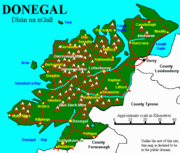County Donegal
|
|
| County Donegal | |
|---|---|

| |
| Area: | 4,841 km² |
| Capital: | Lifford |
| Code: | DL |
| Population: | 137,575 (2002) |
| Province: | Ulster |
- For other uses, see Donegal (disambiguation)
Donegal (Irish: Dún na nGall) is a county in the northwest of Republic of Ireland. It is one of three counties in the province of Ulster that did not become part of Northern Ireland. The name comes from the Irish, meaning "the fort of the foreigners". When first created, it was sometimes referred to as County Tyrconnel (Irish: Tír Chonaill), after the Tyrconnel earldom it succeeded.
DLwik.PNG
Attempts to have the county renamed Tír Chonaill in the late 20th century were abandoned due to objections that the Inishowen peninsula was historically distinct from Tír Chonaill.
- County town: Lifford
- Largest town: Letterkenny (was once the fastest growing town in Western Europe)
- Highest point: Errigal, 752 metres (2,467 feet)
- Tidiest Town Glenties
| Contents |
Geography
Slieve_League-cliffs.jpg
The county consists chiefly of low mountains, with a deeply indented coastline forming natural loughs, of which Lough Swilly is the most notable. The Slieve League cliffs are the second highest sea cliffs in Europe, while Donegal's Malin Head is the most northernly point on the island of Ireland. The climate is temperate and dominated by the Gulf Stream, with cool damp summers and mild wet winters. Two permanently inhabited islands, Arranmore and Tory Island lie off the coast, along with a large number of islands with only transient inhabitants.
Culture/Heritage
Like other areas of Western Ireland, Donegal has a distinctive fiddle tradition.
The variant of the Irish language spoken in Donegal is distinctive, and shares traits with Scottish Gaelic. The Irish Language spoken in the Donegal Gaeltacht (Irish speaking area) is of the West Ulster dialect, while Inishowen, which lost its Gaeltacht areas in the early 20th century, used the East Ulster dialect. Scots is still spoken to a degree in the Laggan district of east Donegal.
Donegal Irish has a strong influence on Irish speakers across the North of Ireland - who find themselves speaking a language noticeably different (in pronunciation) from the 'official' Irish spoken on RTÉ.
Politics
Donegal County Council has responsibility for local administration, and runs alongside the Letterkenny and the Buncrana Urban District Councils. Both the County Council and Urban District Councils have elections every five years (alongside local elections nationally) the last taking place on the 11 June 2004. Twenty nine councellors are elected using the system of Proportional Representation, with a certain amount of seats allocated to each electoral area (of which there are five: Inishowen, Letterkenny, Donegal, Stranorlar, Glenties & Milford). Donegal County Council's main offices are located in the County House in Lifford, but regional offices are located in Carndonagh, Milford, Letterkenny, Dungloe and Donegal. For general (national) elections, the county is divided into two constituencies, Donegal South-West and Donegal North-East, with both having three representatives in Dáil Éireann.
Towns in Donegal
- Ardara
- Ballyshannon, Buncrana, Bundoran, Burtonport
- Carndonagh, Clonmany
- Donegal, Dunfanaghy, Dungloe
- Glenties, Glencolumcille, Greencastle, Gweedore
- Letterkenny, Lifford
- Killybegs
- Milford, Moville, Muff
- Rathmullan
- Stranorlar
External links
- County Donegal.Net ~ Dún-na-nGall.com (http://www.dun-na-ngall.com/)
- Árainn Mhór Island ~ arainnmhor.com (http://www.arainnmhor.com/)
Further Reading
- Template:Book reference(Ireland in Old Photographs series)
Template:Ireland countiesde:Donegal
es:Condado de Donegal
ga:Contae Dhún na nGall
it:Contea del Donegal
nl:County Donegal
ja:ドニゴール州
no:Donegal (grevskap)
pl:Hrabstwo Donegal (Dún na nGall)
ro:Comitatul Donegal
uk:Донегал

